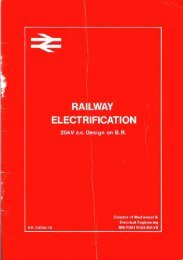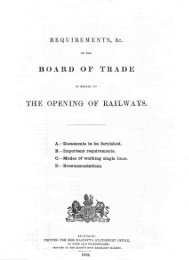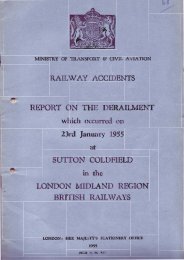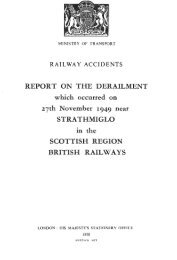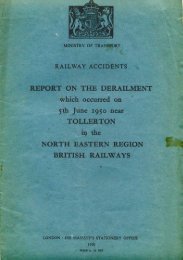R A I LT R AC K - The Railways Archive
R A I LT R AC K - The Railways Archive
R A I LT R AC K - The Railways Archive
You also want an ePaper? Increase the reach of your titles
YUMPU automatically turns print PDFs into web optimized ePapers that Google loves.
<strong>The</strong>se are the route improvements we plan to deliver<br />
CAP<strong>AC</strong>ITY CHANGES TO MEET FRANCHISING DIRECTOR, PTE AND CUSTOMER REQUIREMENTS AND DELIVER ROUTE VISION<br />
<strong>The</strong> route has substantial capacity as it is generally at least double track and signalled with four-aspect colour-light signalling. However, the volume of passenger and freight train movements<br />
on the route is very high. Several route sections are operating at or near to capacity, the principal ones being London–Rugby, Coventry–Birmingham–Wolverhampton,<br />
Stockport–Manchester Piccadilly and the approaches to Glasgow. Other sections of the trunk route will be operating closer to their capacity limit in the near future.<br />
We have carried out a number of capacity analyses for the bottlenecks we identified in the 1998 NMS. In addition, in accordance with undertakings given to the Rail Regulator, we have<br />
carried out strategic capacity reviews in four areas. We have set out below the conclusions from all of these studies.<br />
Euston–Rugby <strong>The</strong> bottleneck constraint is caused by differential speeds and stopping patterns on the fast and slow lines, which will worsen on the slow lines when<br />
the fast lines become dedicated to 125–140mph trains. We have identified the following options to resolve the constraint.<br />
Option A Provide turnback facilities at Watford Junction, Tring and Milton Keynes to optimise slow line capacity and provide high-quality paths on<br />
the slow lines for Silverlink services, especially to and from Northampton.<br />
Option B In order to provide the minimum possible journey time between London and Northampton – about 45 minutes instead of 1 hour – this<br />
option would transfer two trains per hour on to the fast lines. This would require investment in 140mph trains and a grade-separated junction in the<br />
Hanslope area. <strong>The</strong> currently envisaged post-PUG 2 timetable requires some changes to the timetable of passenger trains on the slow lines and this<br />
option would alleviate these problems. <strong>The</strong>se two actual paths consume four standard paths, which could be used by 75mph freight trains and/or<br />
other semi-fast passenger services.<br />
Option C Provide dynamic loops at Tring, Watford and quadrupling of slow lines at Bletchle y. This has previously been assessed and found to<br />
further constrain the timetable pattern and operating flexibility, creating new bottlenecks. This option only creates enough capacity for additional<br />
short-distance trains, which do not satisfy the long-distance market demands on the route.<br />
Option D Provide four slow lines, ie a six-track railway from London to Rugby. This would significantly improve capacity, but gaining full benefit of<br />
this capacity would require substantial further investment in the Trent Valley, and further north. <strong>The</strong> substantial land purchase and construction costs<br />
involved are unlikely to be acceptable or fundable.<br />
Option E Lengthen the journey time of the fast Northampton trains on the slow lines from 2005. This reduces the nominal path consumption of<br />
these trains from four to two paths per hour, thereby freeing up two paths for other services. However, it increases the journey time to<br />
Northampton from 60 minutes to up to 75 minutes.<br />
Option F Reduce freight traffic over this section of the route by operating Felixstowe–West Midlands/North West England trains via Peterborough<br />
and Nuneaton and some other freight trains via Midland Main Line or via Oxford Banbury rather than on the WCML. This option is dependent<br />
upon the freight routeing strategy. It reduces differential speeds between trains, thereby enabling more passenger trains to operate on the slow lines,<br />
thus satisfying the aspirations of our customers for more capacity.<br />
Our preferred option is A, although option F is critical to the long-term management of capacity on the south end of the WCML.<br />
Coventry–Birmingham <strong>The</strong> number of train movements on the route between Coventry and Birmingham has been near the route’s capacity for a number of years. <strong>The</strong>re<br />
are both contracted commitments and customer aspirations to increase the number of train movements over the route. <strong>The</strong> present mixture of fast<br />
and slow trains over the route precludes any further train movements being accommodated without significant operational performance risk.<br />
An engineering feasibility study has been undertaken to assess the options to increase the number of available train paths on this corridor. <strong>The</strong><br />
synopsis of the conclusions reached is set out below.<br />
To increase the corridor’s capacity, it is necessary to reduce the conflict between fast trains and stopping trains. This can only be done by increasing<br />
the number of lines to provide an ‘overtaking’ facility. In addition, the remodelling of Proof House Junction on the approach to Birmingham New<br />
Street Station in 2000 will remove conflicting train movements between this route and those on the Walsall–Lichfield–Longbridge cross-city route .<br />
Thus, there are three options for this bottleneck.<br />
Option A Remodel Proof House as part of the WCRM project and do no other infrastructure work. Run a revised timetable with slow trains<br />
overtaken at Birmingham International Station on existing infrastructure. This would enable a maximum of 12 paths per hour, fully utilising capacity<br />
but not exceeding it. However, a number of customer aspirations would not be met. Additional freight train movements as agreed with the Rail<br />
Regulator can be accommodated.<br />
Option B Provide a four-track railway from Beechwood Tunnel to Stechford, broadly 70% of the route mileage between Coventry and Birmingham.<br />
This would enable all operator aspirations to be met.<br />
Option C Enhance option B by providing a grade-separated junction at Stechford and other works off this route to enable all WCML freight<br />
services to be routed over this corridor.<br />
Our initial analysis suggests that option A produces the best industry value even though all operator aspirations cannot be met. <strong>The</strong> trains<br />
concerned have the lowest industry value over the route.<br />
However, we have included within the partnership elements of schemes to develop the network, option B above providing the only long-term<br />
solution which would substantially increase capacity.<br />
Birmingham–Wolverhampton <strong>The</strong> number of train movements on the route between Wolverhampton and Birmingham has been growing and is now near its capacity. West<br />
Midlands Passenger Transport Authority (Centro) has an aspiration to further increase the number of train movements over the route. <strong>The</strong> present<br />
mixture of fast and slow trains o ver this route limits any future growth in train movements.<br />
In order to accommodate Centro’s aspirations to increase the stopping train service from two to four trains per hour, an ‘overtaking’ facility would<br />
be required. We have assessed the most appropriate facility to be the creation of a four-track railway from Monument Lane Tunnel to Dudley Port.<br />
<strong>The</strong> route between these points would require very substantial reconstruction and additional land. <strong>The</strong> cost of achieving this, solely to operate two<br />
additional trains per hour is not viable for Centro. We have discussed this with Centro who no longer wish to proceed with this aspiration.<br />
<strong>The</strong> route will therefore continue to operate with the present infrastructure.<br />
145



